 Image search results - "Maibara" Image search results - "Maibara" |

Lake Biwa shore. If you leave Maibara Station and head straight for the lake, this is what you will see.
|
|
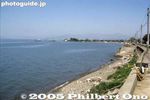
Lake Biwa shore
|
|

Lake Biwa
|
|
|
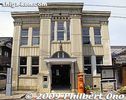
Samegai Museum in a former post office designed by William Merrell Vories, in Samegai, Maibara, Shiga Pref. MAP
|
|

Hachiman Jinja Shrine in Asahi, Maibara. The Asahi Honen Taiko Odori is supposed to be performed at Oka Shrine, but they perform it here on Oct. 4. MAP
|
|

The shrine is on the road going to Nagahama.
|
|

Monument for Asahi village near Hachiman Shrine.
|
|
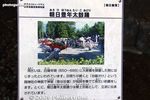
About the Asahi Honen Taiko Odori. It originated in the latter 7th century in Ohara village when they started to cultivate new farming land. It was a rainmaking dance. Now held in Oct. in Maibara.
|
|

Hachiman Shrine grounds where the taiko dance will be performed.
|
|

Hachiman Shrine
|
|
|

Hachiman Shrine
|
|

The Asahi Honen Taiko Odori start walking from the Asahi neighborhood near Hachiman Shrine.
|
|
|

With Mt. Ibuki in the background, the Asahi Honen Taiko Odori dance troupe head for Hachiman Shrine.
|
|

Asahi is the name of the village, and Honen means rich harvest.
|
|
|

Asahi Honen Taiko Odori dancers.
|
|

Asahi Honen Taiko Odori dancers and Mt. Ibuki in Maibara, Shiga.
|
|

The Asahi Honen Taiko Odori dancers arrive at Hachiman Shrine.
|
|
|

The Asahi Honen Taiko Odori dancers at Hachiman Shrine on a beautiful, sunny day on Oct. 4, 2009.
|
|

First they danced in two columns in the center.
|
|
|
|

The Asahi Honen Taiko Odori is a National Intangible Folk Cultural Property.
|
|
|
|
|
|
|

They later danced in a circle.
|
|
|
|
|
|
|
|
|
|
|
|
|

Asahi Honen Taiko Odori dance in Maibara, Shiga.
|
|
|
|
|
|
|
|
|
|

Note that this taiko dance will be canceled if it rains.
|
|

Bamba-juku (Banba-juku) does not have any train stations within walking distance. The closest is Maibara and Samegai Stations. Buses and taxi available. From Samegai, go on Route 21 until you reach this intersection (3 km from Bamba) where you turn left.
|
|

You will soon see this Hokuriku Highway overpass. Go under it.
|
|

Then you'll see a fork in the road. Take the smaller right road which is the former Nakasendo Road.
|
|

The island in the middle has a Bamba-juku monument.
|
|

Bamba-juku monument marking the location of the Kure Ichirizuka milestone. 久禮の一里塚 MAP
|
|

Old Nakasendo Road to Bamba-juku, the sixty-second station or post town (shukuba) of the sixty-nine stations on the Nakasendo Road.
|
|

Bamba-juku is the third Nakasendo station in Shiga, following Samegai-juku which is also in Maibara.
|
|

Finally a small sign on the left declaring "Nakasendo Bamba-no-juku."
|
|

Marker for site of a Toiya-ba which was a travel logistics office where you can get pack horses, forward your baggage, and find a place to stay in Bamba. 問屋場
|
|

Bamba today is a quiet, rural settlement. It is divided into east Bamba and west Bamba.
|
|

Another welcome sign in Bamba-juku.
|
|

Welcome sign in Nakasendo Bamba-juku. (The orange object is a mailbox.)
|
|

Site of another Toiya-ba.
|
|

Intersection with a Bamba-juku stone monument. A good place to rest and eat your box lunch.
|
|

Bamba-juku stone monument.
|
|

Next to the Bamba-juku stone monument is an old map of Bamba-juku.
|
|
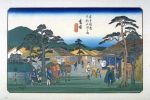
Hiroshige's woodblock print of Banba-juku from his Kisokaido series.
|
|

Stone marker with a finger pointing the way to Maibara Port where you can board a boat to go to Otsu via Lake Biwa. This is at the same intersection across from the Bamba-juku stone monument.
|
|

Site of the Waki-Honjin on the right. Now a modern house. The Waki Honjin was the town's second-best lodge. 脇本陣跡
|
|

Close-up of stone marker for the Waki-Honjin. There are no original buildings left in Bamba-juku related to the post town, except for Rengeji temple.
|
|

Site of the Honjin, the town's most exclusive inn for daimyo lords and other VIPs. This is not the original building. Just a private house. Near the Waki Honjin. 本陣跡
|
|

Going further down the road in Bamba.
|
|

Place where Emperor Meiji took a break. It was the site of another Toiya-ba.
|
|

Marker indicating that Emperor Meiji took a break here once.
|
|

On the left of the road is the path to Rengeji temple.
|
|

Path to Rengeji temple.
|
|

Smack dab in front of Rengeji temple is this monstrosity that is the Meishin Expressway.
|
|

Right after passing under the Meishin Expressway, you see Rengeji's Sanmon Gate. 蓮華寺 山門
|
|

Rengeji is famous as the place where Hojo Nakatoki 北条仲時 and over 430 of his men committed suicide after being defeated by Ashikaga Takauji's forces during the fall of the Kamakura shogunate in 1333. This is a monument for this tragic event.
|
|

On the left of the Sanmon Gate is the "River of Blood." When Hojo Nakatoki and 430 of his men slit themselves on May 9, 1333, the blood became a river flowing here. It was during the Genko War when the Emperor Go-Daigo fought the Kamakura shogun
|
|

"River of Blood" sign. In charge of national security, Hojo Nakatoki was the last Rokuhara Tandai Kitakata chief from the Hojo clan in the Kamakura shogunate. When tourists see this sign, they become scared to enter the temple.
|
|

Rest assured, it's very peaceful in the temple. Rengeji's Sanmon Gate (right) and bell tower on left.
|
|

Wooden insignia on Sanmon Gate with the Imperial crest on the left. The temple was originally founded by Prince Shotoku Taishi about 1,300 years ago. He named it Horyuji 法隆寺. After being struck by lightning, it was rebuilt in 1284.
|
|

Rengeji temple belongs to the Jodo-shu Buddhist sect. The founding priest was Saint Ikko. With support from the lord of Kamaha Castle near Bamba, he was able to rebuild the temple and renamed it Rengeji. 一向上人
|
|

Rengeji Hondo Hall, Banba-juku, Maibara, Shiga. Quite a few emperors favored this temple. The 95th Emperor Hanazono (1297-1348) gave the temple an Imperial sanction to receive Imperial prayers. Hence, the temple's Imperial crest. 蓮華寺
|
|

Until 1943, the temple was a dojo for the Jishu Ikko sect. It then converted to Jodo-shu. Admission is charged, I think 300 yen. There's a unmanned collection box near the entrance.
|
|

Red plum blossoms in front of Rengeji Hondo Hall, in early April.
|
|

Inside Rengeji Hondo Hall, left altar.
|
|

Inside Rengeji Hondo Hall, main altar at the center. There are two figures: Amida Nyorai and Shaka Nyorai. Jodo-shu Buddhist sect. 蓮華寺 本堂
|
|

Inside Rengeji Hondo Hall, main altar at the center. 蓮華寺 本堂
|
|

Inside Rengeji Hondo Hall, right altar.
|
|

Rengeji Hondo Hall's framed nameplate. The temple's name was written by Emperor Go-Mizunoo (1596–1680).
|
|

This is the area where Hojo Nakatoki and his men committed seppuku.
|
|
|
|

Bell tower. Cast during the time of Saint Ikko, the bell is an Important Cultural Property.
|
|

Inside is a Jizo-son statue worshipped for transportation safety.
|
|
|

Memorial for victims of the Pacific War.
|
|

Monument for a poem by Saito Mokichi (1882-1953). 斉藤茂吉の歌碑 「松風の音を聞くときは 古への 聖の如く 我は寂しむ」
|
|

Grave of the lord of Kamaha Castle who helped to rebuild the Rengeji temple.
|
|

Way to the graves of Hojo Nakatoki and his men who committed suicide.
|
|

A few steps up a slope.
|
|

Memorial for Hojo Nakatoki and his men. They had lost to Ashikaga Takauji in the battle at Kyoto and were trying to escape to Kamakura, but was caught by Takauji's forces at Bamba.
|
|

Over 430 gravestones. Hojo Nakatoki and his men were besieged in Bamba by Southern Imperial Court forces. They fought back, but lost and slit their bellies in front of Rengeji's Hondo main hall.
|
|

The temple's third priest wrote the names and age (youngest was 14) of the known fallen warriors in a scroll. He also made these gravestones for them. Visuallly, it's very impressive edifice.
|
|

Graves of Hojo Nakatoki and his men from the Rokuhara Tandai. 北条仲時一行の墓
|
|

The gravestones have five levels. In fall, the surrounding maple leaves turn blood red.
|
|

There are more steps which lead to graves of temple priests and Saint Ikko's mausoleum.
|
|

Graves of previous temple priests.
|
|

Mausoleum of Saint Ikko Shunsho.
|
|

Small mausoleum for Saint Ikko. 一向上人の御廟
|
|

Side of the Hondo
|
|

Behind the Hondo hall is a small hill with the Bamba Chutaro Jizo-son statue.
|
|
|
|

Bamba Chutaro Jizo-son statue, based on a character in the novel "Mabuta-no-Haha" 瞼の母 by Hasegawa Shin (1884-1963) 長谷川伸. 番場忠太郎
|
|

View behind the Hondo.
|
|

Also behind the Hondo is this Ikko-sugi tree, 700 years old. Named after the temple's founding priest Saint Ikko, it was planted where Ikko was cremated. Over 30 meters high and 5 meters wide. 一向杉
|
|

Temple garden. Best during spring when the flowers bloom.
|
|

View from Hondo hall.
|
|

From Rengeji temple, a short distance away on the Nakasendo Road is this path to Naotaka Shrine.
|
|

Naotaka Shrine, dedicated to Lord Ii Naotaka, the third lord of Hikone Castle. 直孝神社
|
|

Naotaka Shrine torii
|
|

There's no explanation about the shrine.
|
|

Naotaka Shrine
|
|

The shrine has no human staff, but a security camera operates.
|
|

Naotaka Shrine Honden Hall
|
|
|
|

Turn left to hike to Kamaha Castle ruins. 鎌刃城
|
|

Map of Kamaha Castle. 鎌刃城
|
|

Path to Kamaha Castle, a mountaintop castle in the distance. Only stone walls remain. 鎌刃城
|
|

Kitano Shrine
|
|

Bamba-juku monument
|
|

A stone found in a river bank. Since it has a hole, it is thought to be a foundation stone for a building's pillar.
|
|
|

Official mascots of Maibara, Shiga Prefecture. A pair of fireflies.
|
|

Rowing off Maibara in northern Shiga. The tall white tower belongs to an elevator manufacturer for testing their elevators. Maibara is best known for Mt. Ibuki and Shiga's one and only shinkansen bullet train station.
|
|

The old Maibara City Hall that was near Maibara Station. Replaced by the new city hall next to Maibara Station.
|
|
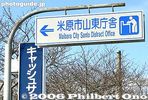
Sign to city hall with misspelled word. "Distract" should be "District."
|
|

Green Park Santo is an outdoor recreational area with exhibition halls, park, lodging, restaurant, tennis courts, and miniature golf.
|
|

Green Park Santo: Spark Santo. Large indoor space. Venue for the annual Bonbai (Bonsai Plum Tree) exhibition during Jan. to March.
|
|

Bonbai (Bonsai Plum Tree) exhibition at Green Park Santo. Held at Green Park Santo's Spark Santo during Jan. to March. The blossoms might not be in bloom during Jan. MAP
|
|

Bonbai (Bonsai Plum Tree) exhibition
|
|

Bonbai (Bonsai Plum Tree) exhibition
|
|
|

Orchid exhibition. Held at the same time and place as the Bonbai (Bonsai Plum Tree) exhibition.
|
|

Green Park Santo: Ibuki no Mieru Bijutsukan (Ibuki Museum of Art). Small exhibition space with meeting rooms. グリーンパーク山東、伊吹の見える美術館
|
|

Ibuki no Mieru Bijutsukan. See Mt. Ibuki from the museum.
|
|

Lodging
|
|

Lodging
|
|

Auto camping area
|
|

Kamo Ike-so ryokan, restaurant and spa
|
|

Kamo Ike-so's winter special: Soba noodles with duck meat.
|
|
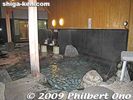
Kamo Ike-so Bihada-no-yu hot spring bath 鴨池荘 美肌の湯
|
|
|

Green Park Santo tennis courts
|
|

Mini golf
|
|
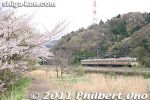
Train going to Omi-Nagaoka Station in spring.
|
|

If you ride the Tokaido Line train between Maibara and Samegai Stations and look out the window in the north, you might notice this low hill called Hinade-yama.Near JR Sakata Station (Hokuriku Line) in former Omi-cho town is Mt. Hinodeyama with Hinode Jinja Shrine holding an annual sumo festival on the third Mon. of Sept. It features mainly children's sumo and a sumo jinku dance by about 16 men.
|
|

If you look carefully, you might notice a manmade structure on Mt. Hinade. Too small to be a castle, doesn't look like a house, looks like a lookout deck.
|
|

One day in 2009, I finally investigated this mountain in Maibara. It's about 2 km from JR Sakata Station on the Hokuriku Line toward Nagahama. You can rent a bicycle at Sakata Station.
|
|

Omi Branch of Maibara City Hall is near the foot of Hinade-yama.
|
|

Large torii in the middle of an intersection. It belongs to Hinade Shrine which is on Mt. Hinade.
|
|

The road around the mountain is decorated with lanterns on the occasion of Hinade Shrine's sumo festival on Sept. 21, 2009.
|
|

Entrance and torii to Hinade Shrine with banners announcing the sumo festival held on the third Mon. of September in Maibara.
|
|

Path to Hinade Jinja Shrine.
|
|
|

A few food and game stalls during the sumo festival.
|
|

Hinade Shrine is dedicated to a god called Sukunahikona-no-Mikoto and Okinaga-sukuneo. 少毘古名命(すくなひこなのみこと)・息長宿禰王(おきながすくねおう)MAP
|
|

Hinade Shrine in Maibara, Shiga Prefecture has Imperial connections as it also worships the legendary Emperor Ojin.
|
|

The shrine also has a sumo ring. In the 13th century, Emperor Go-Toba visited the shrine and watched sumo performed by the local people. He offered a yellow cow to the shrine. This was the start of the shrine's annual sumo festival.
|
|

Mt. Hinodeyama with Hinode Jinja Shrine holds an annual sumo festival on the third Mon. of Sept. It features mainly children's sumo and a sumo jinku dance by about 16 men. For the sumo festival, the sumo ring is decorated with four pillars and pieces of cloth. Near JR Sakata Station (Hokuriku Line) in former Omi-cho town.
|
|

The sumo festival started at 1 pm. They had kids and men on both sides of the sumo ring.
|
|
|
|

The yobidashi caller calls the name of the sumo wrestler.
|
|

The first match was between these two men who had a piece of paper in their mouths.
|
|
|
|
|

Winner. The sumo matches are held as religious ceremony dedicated to the shrine's gods.
|
|

Sanyaku Soroifumi has the top three ranking wrestlers (Ozeki, Sekiwake, Komusubi) stomp the ring to further purify the ring as they face the shrine.
|
|

Yobidashi
|
|

A few more matches by the men were held.
|
|
|
|
|
|
|

Ozeki
|
|

Then the children's sumo matches. Boys only, no girls. This was the main highlight and crowd pleaser.
|
|
|
|
|
|
|

The winners received various household and kitchen goods like towels, pillows, toaster, etc.
|
|
|
|

It wasn't so crowded. There were some photographers, and it received local TV news coverage.
|
|

The children's sumo were based on age. And they got older.
|
|
|
|
|

Prizes to be awarded.
|
|
|
|

A pillow for this winner.
|
|

Then they held the dohyo-iri ring-entering ceremony performed by the men.
|
|

While dressed in formal sumo aprons, they first went to the shrine to pray.
|
|
|

Hinade Shrine's priest blesses the wrestlers.
|
|

The wrestlers then walked to the sumo ring.
|
|
|

The men performing the ring-entering ceremony for the west side.
|
|
|
|
|

The same men perform the ring-entering ceremony for the east side. There were about 20 men.
|
|

After the ring-entering ceremony, the men remained on the ring and performed the sumo odori dance accompanied by sumo jinku singing.
|
|
|
|

Afterward, more children's sumo.
|
|
|
|
|
|

Sumo tournament winners.
|
|

Then for fun, they held random sumo matches regardless of age and size.
|
|

Uneven match.
|
|
|
|

In the end, the boys take home their prizes in a large garbage bag.
|
|

More matches between the men.
|
|

Finally, the bow twirling ceremony (called Yumitori-shiki). Notice that he faces the shrine.
|
|

In the end, they gathered on the sumo ring and clapped their hands in appreciation.
|
|

Map of Mt. Hinade. There are short hiking trails on this low mountain.
|
|

Within the Hinade Shrine grounds is this entrance to a hiking trail going up Mt. Hinade-yama. Elevation is only 240 meters so it's an easy climb.
|
|

Hiking trail on Mt. Hinade.
|
|
|
|
|

Go left.
|
|

Easy hike and well worth it for the great views of Maibara. This is one of those places you've never heard of, but should visit.
|
|

While hiking up, you'll see a few views like this.
|
|

Rock
|
|

Pine tree
|
|

Looking toward Nagahama.
|
|

The lookout deck in view at the end of the trail.
|
|

Now this is what I saw from the train. It is a wooden lookout deck.
|
|
|

Lookout deck on Mt. Hinade.
|
|
|
|

Looking toward Maibara Station. You can see the tiny Heiwado sign with the white dove. That's next to Maibara Station.
|
|

Looking toward Sakata Station which is on the right of the white roof near the center of the picture.
|
|

Lake Biwa and Takeshima island off Hikone.
|
|
|
|

Shinkansen
|
|

Nagahama
|
|

Nagahama Dome and Chikubushima island in the background.
|
|

Nagahama
|
|

Shinkansen
|
|

Looking north
|
|

Meishin Expressway
|
|
| 2054 files on 9 page(s) |
1 |
 |
 |
 |
 |
|